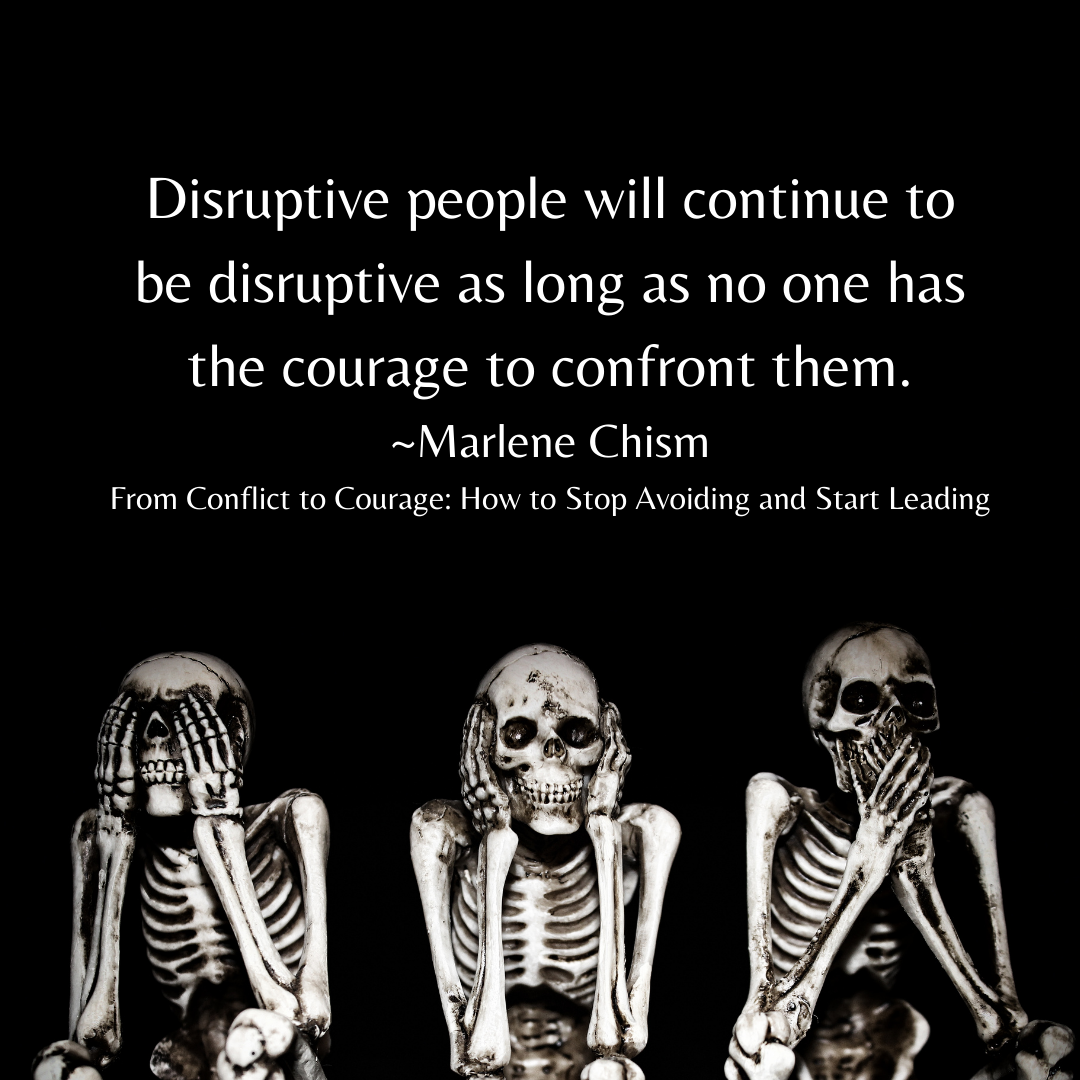Conflict to Courage
No one likes conflict, especially in the workplace, but avoiding it can lead to bigger issues that, if left unresolved, can negatively impact your team and your business. However, conflict isn’t the problem; mismanagement is. Leaders unintentionally mismanage conflict when they turn towards coping mechanisms and patterns like aggression, avoidance, and appeasing.
In her new book, From Conflict to Courage: How to Stop Avoiding and Start Leading, Marlene Chism demonstrates how to fearlessly deal with conflict head-on by expanding your conflict capacity, which is a combination of three elements: the Inner Game, the Outer Game, and Culture.
I reached out to her to learn more.
Right from the first words of your book, you reframe conflict as an opportunity and not a problem, saying “Leaders have an opportunity to be a channel for chaos or a catalyst for clarity.” Talk about that and the opportunity conflict offers.
The way a leader “sees” and perceives conflict shapes their decision-making. If a leader perceives conflict as a problem, they’ll try to avoid it, and avoidance creates a bigger problem in the future. Avoidance is a short-term strategy based on how we feel in the moment. When we avoid, we trade the growth of the future for the comfort of the moment. In contrast, those who see conflict as a teacher, willingly open up for expansive leadership growth. This is what I call the “inner game” of conflict capacity—the ability to initiate, engage in, and resolve conflict while staying aligned to your values. The evidence that you’re growing in conflict capacity is when what you used to avoid, now makes you curious to learn more.
What are some of the dangers of avoiding conflict?
 Almost every big conflict can be traced back to a conversation that should have happened but didn’t. For example, if you avoid telling your boss that you’re struggling with a couple of employees, you may be surprised two years later to find the organization in litigation over claims that you discriminated based on age, gender, religion, or race. The original problem might have had absolutely nothing to do with these issues, but because you avoided a conversation with the employees who were complaining, as well as your own boss, you now have a bigger problem. Your boss feels blindsided, and the employees feel ignored, invisible, and misunderstood.
Almost every big conflict can be traced back to a conversation that should have happened but didn’t. For example, if you avoid telling your boss that you’re struggling with a couple of employees, you may be surprised two years later to find the organization in litigation over claims that you discriminated based on age, gender, religion, or race. The original problem might have had absolutely nothing to do with these issues, but because you avoided a conversation with the employees who were complaining, as well as your own boss, you now have a bigger problem. Your boss feels blindsided, and the employees feel ignored, invisible, and misunderstood.
Avoiding affects the culture by diminishing trust. An example of avoiding in this instance is a leader who tries to keep the peace by moving a problem employee to another department. I’ve heard leaders say, “I’ve nipped this problem in the bud,” when in fact they just clipped off the bloom on a dandelion and the weed starts to spread. Avoidance sets an example of ineffective leadership that’s hard to ignore from the front line.
What are some of the signs of a leader who is irresponsible, avoids conflict, and is not empowering employees?
Irresponsible leadership behaviors include covering for employees, allowing excuses, not setting appropriate boundaries, fixing problems, micromanaging, appeasing, missing deadlines, not holding employees accountable, and not keeping an eye on the progress. These behaviors are rooted in leadership identity.
Three that I mention in the book are the hands-off, hero, and best friend. The Hands-Off leader wants to believe that “we’re all adults” and “I shouldn’t have to micromanage.” They trust that everything’s going to be OK. Generally, there’s a lack of accountability among leaders who see themselves as “hands-off.” The Hero leader likes to have the answer and fix employee problems. This leader was once a star performer, and they still crave the accolades. They don’t know how to coach others. Instead, they are motivated to be the hardest worker and have the answers. As a result, they enable their team instead of empowering them. Then there’s the Best Friend leader who just wants to be liked. The Best Friend leader doesn’t identify with being a leader, they identify with being “nice.” Their open door has become a revolving door as they listen to gossip, and fix employees’ personal problems. Best Friend leaders try to make sure everyone is happy, even if that means overriding policy or offering special favors to their favorite team members.

How should a leader deal with high-conflict people who are disrupting the workplace?
The first thing a leader needs to do when dealing with high-conflict people is to define the observable (disruptive) behavior and understand how this behavior disrupts the organization, workplace, or team. This happens before you ever utter a word to the disruptive employee.
When you define the observable behavior, you are basically asking the question, “What is happening that should not be happening?” For example, rather than saying, “Kim has a bad attitude and is disruptive at meetings,” you say instead, “Kim interrupted six times at the last meeting and started an argument that was unrelated to the agenda. This has caused two people on the team to shut down and disengage.”
Once you have identified the observed behavior and the impact, you schedule a specific time with the individual to initiate a conversation for the purpose of supporting that individual to positive change.
You help leaders have difficult conversations. One part of that is setting the intention of the meeting. Would you give an example of a good versus poor intention setting?
Think of an intention as a “goal with a soul.” Setting intention considers an end result, but also considers the journey. On the journey is a human being who may have blind spots. Setting an intention is like saying, “Here’s our north star. If we get lost, we will return to this north star, so we stay focused and move forward.”
A poor intention sounds punitive and is backward-focused, whereas a good intention is forward-focused and unifying. It’s the difference between, “My intention is to find out why your sales are lagging,” versus “My intention is to support you to get your sales numbers up.”
The reason setting a good intention works is that it calms the person you’re talking with. Their brain doesn’t have to be in fight mode. They can relax. They have certainty about why this conversation is occurring. They know the direction you are going, and if they throw out a distraction such as “that’s not fair,” or “that’s not the way it was done last year,” you can say, “perhaps, but our intention for today is…” Intentions provide emotional safety and guidance in difficult conversations.
What is your advice to the new leader who wants to embrace these principles?
 Leaders who want to embrace these principles can start by identifying the core values they want to lead by, as well as the values of the organization. Next, leaders can work on building their leadership identity and define how they want to show up as a leader. Don’t wait for the organization to develop you. Decide in advance you are going to develop yourself.
Leaders who want to embrace these principles can start by identifying the core values they want to lead by, as well as the values of the organization. Next, leaders can work on building their leadership identity and define how they want to show up as a leader. Don’t wait for the organization to develop you. Decide in advance you are going to develop yourself.
Join LinkedIn learning, for example, and take online courses, or join a book club to discuss these principles, but beware of shallow development. You have to embody what you learned. This is not about passing a written exam. Everyone knows the answers in a workshop. As I said before, conflict is your best teacher. You’ll know where you need to grow by how you got through the last conflict. Leadership growth doesn’t come only from courses, workshops, or reading, but from deliberate practice. Take one skill and try it over and over until it becomes part of who you are. That’s how real leadership development works. What free weights are to your fitness gym, conflict is to your leadership muscle. You have to do the work.
For more information, see: From Conflict to Courage: How to Stop Avoiding and Start Leading.
Image Credit: tim-gouw

